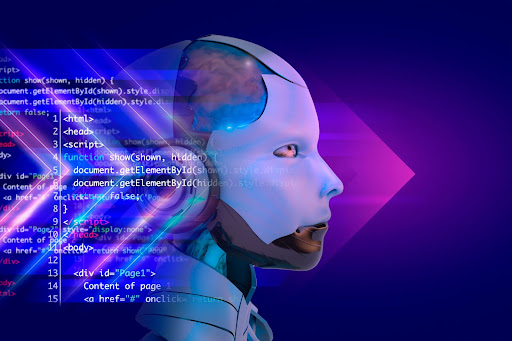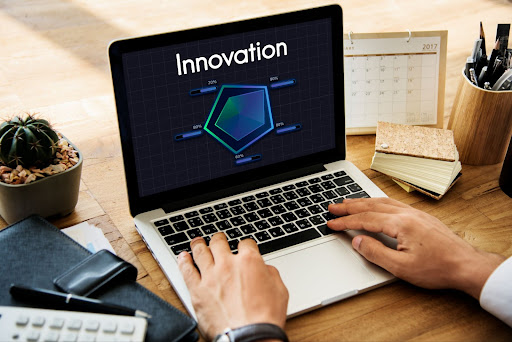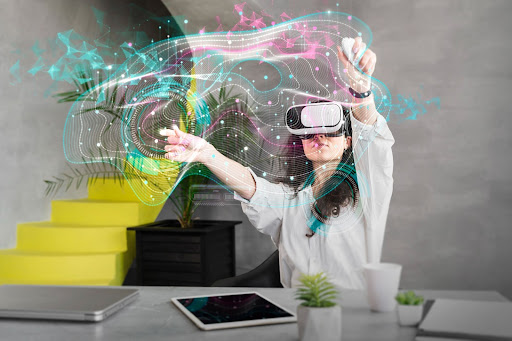Web Development encompasses the process of creating websites and web applications, involving various tasks like web design, front-end development, back-end programming, and database management. It has evolved significantly over the years, constantly adapting to changing technologies and user expectations.
Artificial Intelligence (AI) and Machine Learning (ML) emerged to herald a new era in computing. Researchers and innovators explored ways to enable machines to learn from data, make intelligent decisions, and mimic human-like behaviors. This breakthrough brought about promising capabilities for various industries, including web development.
Below, we’ll investigate the impact of AI and ML on web programming by outlining diverse applications of smart tech in this sphere and highlighting the benefits and challenges those applications come with.
The Use of AI and Machine Learning in Web Development

In recent years, intelligent technologies have seamlessly integrated into web development practices. Programmers now harness the power of AI-driven tools and frameworks to craft more intelligent, efficient, and user-centric digital experiences, automate repetitive tasks, and gain valuable insights from user data. Let’s consider how smart tech can be utilized in this industry.
Natural Language Processing (NLP)
This advanced technology allows for automating the creation of engaging and relevant content. NLP algorithms analyze huge sets of data, enabling websites to generate coherent articles, product descriptions, and personalized messages, making content creation more efficient and effective.
Personalization and Recommendation Systems
AI – Powered Search track user behavior, preferences, and interactions to deliver tailored experiences. Recommendation systems utilize this data to suggest products, content, or services, enhancing user satisfaction and driving engagement on websites and e-commerce platforms.
Predictive Analytics
The method leverages ML to anticipate user actions, choices, and habits based on historical data. Web developers can use this information to optimize user journeys, identify potential drop-off points, and provide custom-tailored content or offers, thus improving overall user experience.
Image and Video Recognition
AI-driven image and video recognition have revolutionized web development by enabling automatic tagging, content categorization, and even object detection within multimedia content. This enhances search capabilities, content organization, and accessibility for users.
Voice and Speech Recognition
Voice and speech recognition technologies have gained traction with the rise of voice-controlled devices and virtual assistants. Web programmers now integrate voice interfaces to facilitate hands-free interactions and voice search, making sites more user-friendly and accessible.
A/B Testing and Optimization
Using this method, developers get an opportunity to compare multiple versions of web elements to determine the most effective ones. ML algorithms analyze user responses to streamline web design, layout, and content, leading to higher conversion rates and better user experiences.
A/B testing and optimization are crucial techniques for improving the effectiveness and performance of loan apps. They help you make data-driven decisions to enhance user experience, increase conversion rates, and achieve better outcomes. For example, A/B testing and optimization for loan apps or websites: Determine the specific goals you want to achieve through A/B testing. These could include increasing loan application submissions, improving conversion rates, reducing bounce rates, or enhancing user engagement. Define the metrics that will measure success for each goal.
Chatbots and Virtual Assistants
Conversational agents have transformed customer support and brought user engagement techniques to the next level. These digital tools use NLP and ML to understand user inquiries and provide real-time assistance, creating a seamless and interactive user experience.
Benefits and Challenges of AI and ML Implementation in Web Development
By integrating smart technologies, developers can leverage a wide range of benefits that enhance user experience, streamline development workflows, and optimize website performance.
On the other hand, though, these techs entail certain challenges and limitations that need to be addressed to ensure successful AI and ML integration into the web development process.
Benefits to Embrace

- Improved user experience: By analyzing user behavior and preferences, AI algorithms can personalize content, recommend relevant products, and optimize the user interface, ensuring that visitors have a seamless and tailored journey. This leads to higher user satisfaction, increased engagement, and improved retention rates.
- Enhanced personalization: AI-enabled personalization goes beyond generic recommendations. It delves into user data, such as browsing history, demographics, and past interactions, to offer truly personalized experiences. Whether it’s individual product suggestions, content recommendations, or customized user interfaces, the tech helps enhance involvement by delivering precisely what users need.
- Efficient content generation: NLP streamlines the time-consuming and resource-intensive process of content creation by automatically generating high-quality copy. Web developers can employ NLP models to create blog posts, product descriptions, and even personalized emails, freeing up time for other creative tasks.
- Data-driven decision-making: Capable of analyzing large datasets, AI algorithms can identify patterns, trends, and user activities that human analysis might miss. Armed with this information, programmers can make informed decisions on design changes, content optimization, and overall site enhancements.
- Real-time observations: With intelligent tech on their side, web developers can access real-time data and insights on user interactions and site performance. They will be able to make prompt adjustments and optimizations, ensuring that the site is always up-to-date and responsive to user needs.
- Repetitive task automation: From image optimization and content tagging to A/B testing and performance monitoring, AI-driven automation reduces manual workload and allows developers to focus on more strategic aspects of the development process, much like how an advanced algorithm predicts Ethereum price trends in the volatile cryptocurrency market.
In a word, embracing AI in web development is a promising step towards building a more intelligent, efficient, and engaging online presence.
Challenges to Tackle

- Ethical concerns: Programmers should grapple with questions related to data privacy, transparency, and user consent. Ensuring that smart algorithms do not engage in unethical practices is vital. Striking a balance between AI-driven personalization and user privacy becomes a challenge that demands careful consideration.
- Bias and fairness issues: Intelligent systems can inadvertently inherit biases present in the data they are trained on, leading to biased outcomes. In web development, this can result in prejudiced content recommendations, unfair treatment of users, or exclusion of certain demographics. Addressing and mitigating bias requires continuous monitoring and corrective measures.
- Privacy and security concerns: AI-driven web applications largely rely on user data which raises concerns about data privacy and security. It’s a must to implement robust data protection measures and ensure compliance with relevant regulations to safeguard user information from unauthorized access or misuse.
- Technical complexities: Developers may face challenges in understanding and implementing sophisticated AI algorithms and models. Overcoming the learning curve and keeping up with rapid advancements in technology requires dedicated effort and continuous learning.
- High implementation costs: AI applications often demand significant computational resources, including powerful hardware and cloud infrastructure. This can lead to increased operational expenses. Balancing the benefits of AI with its resource-intensive nature can be a limitation, especially for smaller organizations with limited budgets.
By fostering a culture of ethical practices, prioritizing data privacy, and managing technical concerns, developers can harness the full potential of smart tech while ensuring a secure, fair, and inclusive digital environment.
AI and ML in Web Development: What’s Around the Corner

As technology evolves, it will present more exciting capabilities for programmers and businesses alike. Let’s sneak peek into the future trends to unlock new opportunities for creating innovative, user-centric, and secure digital experiences.
Integration Into Web Development Frameworks
Integration into web development frameworks will become more seamless and accessible. Programmers can expect AI-powered tools and libraries that further streamline tasks like natural language processing, recommendation systems, and user behavior analysis. It will enable developers to create more intelligent and dynamic websites with enhanced user experiences. Search Solution LLC is the best website that offers all services related to website development in all over the wrold.
AI-Generated Web Design and Layouts
Smart algorithms can analyze user preferences, industry trends, and design principles to automatically generate aesthetically pleasing and user-friendly site layouts. This capability will expedite the web development process while ensuring visually appealing and intuitive interfaces.
Increased Use of Smart Tech in SEO
Smart tools can analyze search trends, user intent, and competitor data to optimize content for higher search rankings and better user engagement. Moreover, AI-generated copy will complement human-created materials to effectively cater to specific audience segments.
Real-Time Website Customization
With AI, ongoing site customization will become more prevalent. As users interact with platforms, intelligent algorithms can adapt the content, layout, and product recommendations in real time based on individual preferences and activities, thus, driving conversion rates.
Cyber Security for Web Applications
Smart systems can detect and respond to cybersecurity threats in real time, mitigating risks and protecting user data from cyber-attacks. Advanced AI algorithms will continuously learn and evolve to counter emerging threats more and more effectively.
Conclusion
To recap, the story of AI and ML in web development has just begun and there is still a lot to come. Yet, these techs have already redefined the industry paving the way for a future where intelligent and personalized digital experiences are the norm.
By harnessing AI’s capabilities responsibly and ethically, we can collectively shape a digital landscape that empowers users, enhances interactions, and continues to push the boundaries of web development in exciting and innovative ways.

